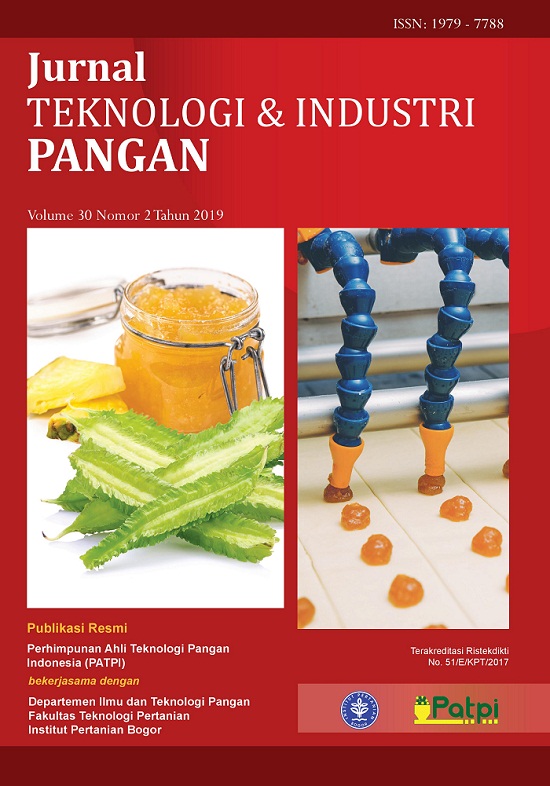PEMURNIAN DAN KARAKTERISASI PEDIOSIN YANG DIPRODUKSI OLEH Pediococcus pentosaceus 2A2
Abstract
References
Abbasiliasi S, Tan JS, Ibrahim TAT, Kadkhodaei S, Ng HS, Vakhshiteh F, Ajdari Z, Mustafa S, Ling TC, Rahim RA, Ariff AB. 2014. Primary reco-very of a bacteriocin-like inhibitory substance derived from Pediococcus acidilactici Kp10 by an aqueous two-phase system. Food Chem 151: 93-100. DOI: 10.1016/j.foodchem.2013.11. 019.
Altuntas EG, Cosansu S, Ayhan K. 2010. Some growth parameters and antimicrobial activity of a bacteriocin-producing strain Pediococcus aci-dilactici 13. Int J Food Microbiol 141: 28-31. DOI: 10.1016/j.ijfoodmicro.2010.04.024.
Anastasiadou S, Papagianni M, Filiousis G, Ambro-siadis I, Koidis P. 2008. Rapid quantifiable assessment of nutritional parameters influen-cing pediocin production by Pediococcus acidi-lactici NRRL B5627. Bioresour Technol 99: 6646-6650. DOI: 10.1016/j.biortech.2007.11. 068.
Arief II, Jakaria, Suryati T, Wulandari Z, Andreas E. 2013. Isolation and characterization of plantari-cin produced by Lactobacillus plantarum strains (IIA-1A5, IIA-1B1, IIA-2B2). Media Peternakan 2013: 91-100. DOI: 10.5398/medpet.2013.36.2. 91.
Arief II, Budiman C, Jenie BSL, Andreas E, Yuneni A. 2015a. Plantaricin IIA-1A5 from Lactobacillus plantarum IIA-1A5 displays bactericidal activity against Staphylococcus aureus. Benef Micro-bes 6: 603-613. DOI: 10.3920/BM2014.0064.
Arief II, Jenie BSL, Astawan M, Fujiyama K, Witarto AB. 2015b. Identification and probiotic charac-teristics of lactic acid bacteria isolated from Indonesian local beef. Asian J Anim Sci 9: 25-36. DOI: 10.3923/ajas.2015.25.36.
Bhattacharya S, Das A. 2010. Study of physical and cultural parameters on the bacteriocins pro-duced by lactic acid bacteria isolated from tradi-tional Indian fermented foods. Am J Food Technol 5: 111-120. DOI: 10.3923/ajft.2010.11 1.120.
Devi SM, Halami PM. 2011. Detection and Charac-terization of Pediocin PA-1/AcH like Bacteriocin Producing Lactic Acid Bacteria. Curr Microbiol 63: 181-185. DOI: 10.1007/s00284-011-9963-8.
Devi SM, Ramaswamy AM, Halami PM. 2014. In situ production of pediocin PA-1 like bacteriocin by different genera of lactic acid bacteria in soy-milk fermentation and evaluation of sensory properties of the fermented soy curd. J Food Sci Technol 51: 3325-3332. DOI: 10.1007/s131 97-012-0870-1.
Elayaraja S, Neelamegam A, Packiyam M, Thanga-vel B. 2014. Production, purification and cha-racterization of bacteriocin from Lactobacillus murinus AU06 and its broad antibacterial spec-trum. Asian Pac J Trop Biomed 4: 305-311. DOI: 10.12980/APJTB.4.2014C537.
Garsa AK, Kumariya R, Sood SK, Kumar A, Kapila S. 2014a. Bacteriocin production and different strategies for their recovery and purification Probiotics Antimicrob Proteins 6: 47-58. DOI: 10.1007/s12602-013-9153-z.
Garsa AK, Kumariya R, Kumar A, Lather P, Kapila S, Sood SK. 2014b. Industrial cheese whey uti-lization for enhanced production of purified pe-diocin PA-1. Food Sci Technol 59: 656-665. DOI: 10.1016/j.lwt.2014.07.008.
Hata T, Tanaka R, Ohmomo S. 2010. Isolation and characterization of plantaricin ASM1: A new bacteriocin produced by Lactobacillus planta-rum A-1. Int J Food Microbiol 137: 94-99. DOI: 10.1016/j.ijfoodmicro.2009.10.021.
Jodoin J, Hincke MT. 2018. Histone H5 is a potent antimicrobial agent and a template for novel an-timicrobial peptides. Sci Rep 8: 1-15. DOI: 10.1 038/s41598-018-20912-1.
Kashani HH, Nikzad H, Mobaseri S, Hoseini ES. 2012. Synergism effect of nisin peptide in redu-cing chemical preservatives in food industry. Life Sci J 9: 496-501.
Kaur G, Singh P, Malik RK, Bhardwaj A. 2012. Me-chanism of nisin, pediocin 34, and enterocin FH99 resistance in Listeria monocytogenes. Probiotics Antimicrob Proteins 4: 11-20. DOI: 10.1007/s12602-011-9085-4.
Khan HU. 2012. The role of Ion Exchange Chroma-tography in purification and characterization of molecules. https://www.intechopen.com/books/ ion-exchange-technologies/the-role-of-ion-ex change-chromatography-in-purification-and-cha racterization-of-molecules [02 Agustus 2018].
Kingcha Y, Tosukhowong A, Zendo T, Roytrakul S, Luxananil P, Chareonpornsook K, Valyasevi R, Sonomoto K, Visessanguan W. 2012. Antiliste-ria activity of Pediococcus pentosaceus BCC 3772 and application as starter culture for Nham, a traditional fermented pork sausage. Food Control 25: 190-196. DOI: 10.1016/j.food cont.2011.10.005.
Lowry OH, Rosebrough NJ, Farr AL, Randall R.J. 1951. Protein measurement with the Folin phe-nol reagent. J Biol Chem 193: 265-275.
Ly KCD, Gabelli SB. 2014. Salting out of proteins using ammonium sulfate precipitation. Methods Enzymol 541: 85-94. DOI: 10.1016/B978-0-12-420119-4.00007-0.
Mehla J, Sood SK. 2011a. Acidic pH enhanced acti-vity/yield of an YGNGV motif containing anti-microbial peptide isolated and purified from Pe-diococcus pentosaceus NCDC273, a dairy strain. Int J Probiotics Prebiotics 6: 81-88.
Mehla J, Sood SK. 2011b. Substantiation in Entero-coccus faecalis of dose-dependent resistance and cross-resistance to pore-forming antimicro-bial peptides by use of a polydiacetylene-based colorimetric assay. Appl Environ Microbiol 77: 786-793. DOI: 10.1128/AEM.01496-10.
Nissen-Meyer JN, Rogne P, Oppegard C, Haugen HS, Kristiansen PE. 2009. Structure-function relationships of the non-lanthionine-containing peptide (class II) bacteriocins produced by gram-positive bacteria. Curr Pharm Biotechnol 10: 19-37. DOI: 10.2174/1389201097870486 61.
Mulyani S, Jenie BSL, Kusumaningrum HD, Arief II. 2019. Characterisation of crude bacteriocin pro-duced by Pediococcus pentosaceus 2A2 in en-riched molasses medium. Int Food Res J 26: 187-192.
Papagianni M, Anastasiadou S. 2009. Pediocins: The bacteriocins of Pediococci. Sources, pro-duction, properties and applications. Microb Cell Fact 8: 1-16. DOI: 10.1186/1475-2859-8-3.
Pharmacia Biotech. 2016. Sephadex ion exchange media. http://www.chembio.uoguelph.ca/educ mat/chm357/sephadex.pdf [1 November 2016].
Rodriguez JM, Martinez M, Kok J. 2002. Pediocin PA-1, a wide-spectrum bacteriocin from lactic acid bacteria. Crit Rev Food Sci Nutr 42: 91-121. DOI: 10.1080/10408690290825475.
Simha BV, Sood SK, Kumariya R, Garsa AK. 2012. Simple and rapid purification of pediocin PA-1 from Pediococcus pentosaceous NCDC 273 suitable for industrial application. Microbiol Res 167: 544-549. DOI: 10.1016/j.micres.2012.01. 001.
Sood SK, Simha BV, Kumariya R, Garsa AK, Mehla J, Meena S, Lather P. 2013. Highly specific culture-independent detection of YGNGV motif-containing pediocin-producing strains. Probio-tics Antimicro 5: 37-42. DOI: 10.1007/s1260201 2-9114-y.
Tiwari SK, Srivastava S. 2008. Purification and cha-racterization of plantaricin LR14: a novel bacte-riocin produced by Lactobacillus plantarum LR/ 14. Appl Microbiol Biotechnol 79: 759-767. DOI: 10.1007/s00253-008-1482-6.
Todorov SD, Dicks LMT. 2009. Bacteriocin produc-tion by Pediococcus pentosaceus isolated from Marula (Scerocarya birrea). Int J Food Microbiol 132: 117-126. DOI: 10.1016/j.ijfoodmicro.2009. 04.010.
Todorov SD, Wachsman M, Tome E, Dousset X, Destro MT, Dicks LMT, Franco BDGM, Velho MV, Drider D. 2010. Characterisation of an anti-viral pediocin-like bacteriocin produced by Ente-rococcus faecium. Food Microbiol 27: 869-879. DOI: 10.1016/j.fm.2010.05.001.
Wang G, Feng G, Synder AB, Manns D, Churey JJ, Worobo RW. 2014. Bactericidal thurincin H causes unique morphological changes in Baci-llus cereus F4552 without affecting membrane permeability. FEMS Microbiol Lett 357: 69-76. DOI: 10.1111/1574-6968.12486.

